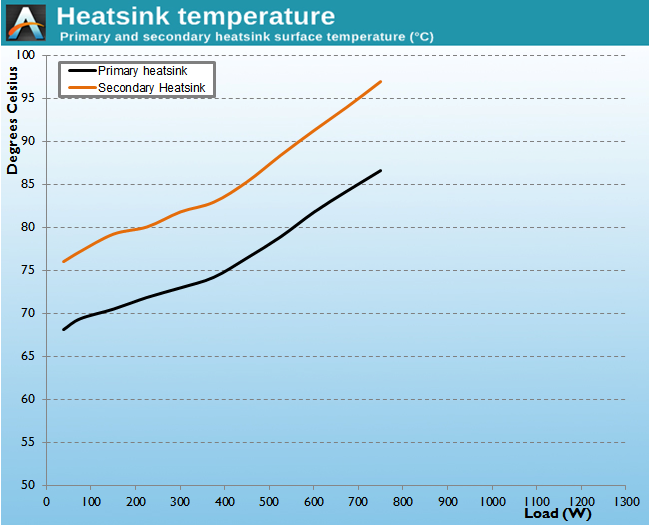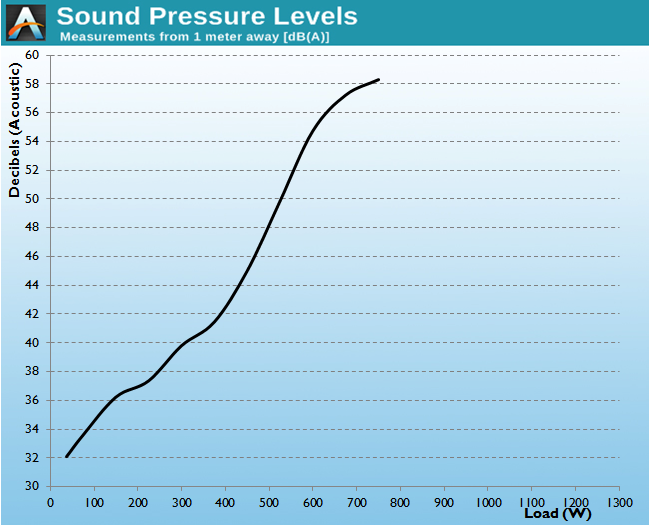The Rosewill Quark Series Power Supply Review (750W, 850W, 1000W, 1200W)
by E. Fylladitakis on January 13, 2016 9:00 AM EST- Posted in
- Cases/Cooling/PSUs
- Rosewill
- 80Plus Platinum
Hot Test Results
Switching over to our hot testing results, as we see in the following tables, the Rosewill Quark PSUs generally offer very good power quality. The maximum ripple on the 12V lines is below 42 mV under full load, with the 750W version displaying weaker filtering than that of the more advanced platforms. The filtering of the 3.3V/5V voltage lines is very good as well, with our maximum reading being 34 mV when the 1200W version was heavily cross-loaded. Voltage regulation is good, at about 2% for the 850W to 1200W version and about 1.4% for the 750W version of the Quark.
| Rosewill Quark 750W - Main Output | ||||||||
| Load (Watts) | 152.03 W | 379.52 W | 563.81 W | 748.51 W | ||||
| Load (Percent) | 20.27% | 50.6% | 75.17% | 99.8% | ||||
| Amperes | Volts | Amperes | Volts | Amperes | Volts | Amperes | Volts | |
| 3.3 V | 1.98 | 3.38 | 4.94 | 3.36 | 7.41 | 3.33 | 9.88 | 3.32 |
| 5 V | 1.98 | 5.16 | 4.94 | 5.13 | 7.41 | 5.09 | 9.88 | 5.05 |
| 12 V | 11.13 | 12.14 | 27.83 | 12.13 | 41.75 | 12.01 | 55.67 | 11.96 |
| Line | Regulation (20% to 100% load) |
Voltage Ripple (mV) | |||||
| 20% Load | 50% Load | 75% Load | 100% Load | CL1 12V |
CL2 3.3V + 5V |
||
| 3.3V | 1.6% | 12 | 12 | 12 | 14 | 14 | 12 |
| 5V | 2% | 14 | 20 | 22 | 22 | 26 | 16 |
| 12V | 1.5% | 30 | 36 | 36 | 40 | 36 | 42 |
| Rosewill Quark 850W - Main Output | ||||||||
| Load (Watts) | 172.7 W | 429.61 W | 635.84 W | 846.17 W | ||||
| Load (Percent) | 20.32% | 50.54% | 74.8% | 99.55% | ||||
| Amperes | Volts | Amperes | Volts | Amperes | Volts | Amperes | Volts | |
| 3.3 V | 2.27 | 3.39 | 5.67 | 3.36 | 8.51 | 3.32 | 11.35 | 3.31 |
| 5 V | 2 | 5.16 | 4.99 | 5.15 | 7.49 | 5.08 | 9.99 | 5.05 |
| 12 V | 12.71 | 12.17 | 31.78 | 12.11 | 47.66 | 11.95 | 63.55 | 11.93 |
| Line | Regulation (20% to 100% load) |
Voltage Ripple (mV) | |||||
| 20% Load | 50% Load | 75% Load | 100% Load | CL1 12V |
CL2 3.3V + 5V |
||
| 3.3V | 2.2% | 10 | 12 | 18 | 22 | 20 | 24 |
| 5V | 2.3% | 10 | 16 | 18 | 26 | 22 | 26 |
| 12V | 2% | 16 | 20 | 26 | 36 | 36 | 30 |
| Rosewill Quark 1000W - Main Output | ||||||||
| Load (Watts) | 203.05 W | 503.92 W | 750.6 W | 996.17 W | ||||
| Load (Percent) | 20.31% | 50.39% | 75.06% | 99.62% | ||||
| Amperes | Volts | Amperes | Volts | Amperes | Volts | Amperes | Volts | |
| 3.3 V | 2.27 | 3.39 | 5.68 | 3.37 | 8.52 | 3.32 | 11.37 | 3.31 |
| 5 V | 2.27 | 5.16 | 5.68 | 5.15 | 8.52 | 5.06 | 11.37 | 5.05 |
| 12 V | 15.09 | 12.17 | 37.74 | 12.07 | 56.6 | 12 | 75.47 | 11.94 |
| Line | Regulation (20% to 100% load) |
Voltage Ripple (mV) | |||||
| 20% Load | 50% Load | 75% Load | 100% Load | CL1 12V |
CL2 3.3V + 5V |
||
| 3.3V | 2.4% | 12 | 16 | 20 | 22 | 20 | 26 |
| 5V | 2.2% | 14 | 18 | 20 | 24 | 20 | 28 |
| 12V | 1.9% | 20 | 22 | 28 | 34 | 36 | 36 |
| Rosewill Quark 1200W - Main Output | ||||||||
| Load (Watts) | 243.25 W | 607.74 W | 902.88 W | 1196.86 W | ||||
| Load (Percent) | 20.27% | 50.65% | 75.24% | 99.74% | ||||
| Amperes | Volts | Amperes | Volts | Amperes | Volts | Amperes | Volts | |
| 3.3 V | 2.31 | 3.38 | 5.79 | 3.38 | 8.68 | 3.33 | 11.57 | 3.32 |
| 5 V | 2.04 | 5.17 | 5.09 | 5.15 | 7.64 | 5.07 | 10.18 | 5.04 |
| 12 V | 18.51 | 12.15 | 46.29 | 12.14 | 69.43 | 12.03 | 92.57 | 11.96 |
| Line | Regulation (20% to 100% load) |
Voltage Ripple (mV) | |||||
| 20% Load | 50% Load | 75% Load | 100% Load | CL1 12V |
CL2 3.3V + 5V |
||
| 3.3V | 1.9% | 14 | 18 | 24 | 26 | 24 | 30 |
| 5V | 2.4% | 16 | 18 | 26 | 30 | 26 | 34 |
| 12V | 1.6% | 20 | 26 | 34 | 38 | 40 | 32 |
Once again, we need to mention that these PSUs are rated at 40°C and we perform our testing at temperatures higher than 45°C - we could reduce the ambient temperature of our hotbox testing but we chose not to do so as the results would then not be comparable to those of our previous reviews.
High ambient temperatures have a significant impact on the electrical performance of the Quark PSUs. The average energy efficiency reduction is 2.5%, with the drop being very high when the units are heavily loaded, reaching 4.3% in the case of the fully loaded 750W version. Considering that these are units rated for operation at 40°C, running them at maximum capacity in higher temperatures are overload conditions for the Quark PSUs, which do well enough maintaining reasonable performance and power quality.

| Efficiency |

| Power Losses |
The internal temperatures per % capacity of the Quark PSUs inside the hotbox are nearly identical between the four units, with all four units reaching almost 100°C under full load. There are measurable thermal performance differences between the units, as the actual difference for a specific load is sometimes more than a few temperature degrees. This is especially true between the 750W version and the more powerful units, which are different platforms.

| Intake & Exhaust Air Temperature |

| Heatsink Temperature |
With such high internal temperatures, it was given that the speed of the fans would greatly increase, as the cooling system would strive to maintain operational temperatures within the units. For the 850W to 1200W versions, all three units display a linear increase of the fan's speed as the load increases, with the noise level reaching up to about 50 dB(A) at maximum load. The 1200W is slightly louder than the other two units, with a maximum of nearly 54 dB(A). What surprised us was the acoustics performance of the 750W version, which is greatly inferior to that of the significantly more powerful units. The rate at which the SPL increases significantly higher, with the 750W unit reaching a maximum of nearly 58 dB(A), making it much louder than the more powerful (and different platform) 850W version. As the speed of the fan was not much greater at this point, we can only surmise that the ball bearing fan of the 750W version has a significantly louder engine or that somehow a much stronger aerodynamic drag is being created by the fan or inside the unit.

| Sound Pressure Level |










34 Comments
View All Comments
RaduZ - Thursday, January 14, 2016 - link
What's so great about these PSUs ? That platinum raiting means nothing... I was looking at the 750W one, if you compare it to lets say the Super Flower Leadex 750W Gold (or EVGA Supernova for the US market) it has the same price, in tests the SF has almost the same eficiency and way better regulation and better ripple control. (both are 130$ on newegg)kaborka - Monday, January 18, 2016 - link
One thing that is really important to me to see in a PSU review is whether it will work with a non-sinewave UPS or if the active PFC will shut it down. I have a significant investment in older UPS units and need compatible PSUs.shadowjk - Saturday, January 23, 2016 - link
Amen to that! This is very interesting to me too.Not only whether the Active PFC will cause problems, but also for us europeans whether the components such as the capacitors on the PSU can withstand the higher peak to peak voltage created by modified sine UPSes as compared to the peak to peak voltage of a real sine wave.
Oxford Guy - Friday, January 22, 2016 - link
"What surprised us was the acoustics performance of the 750W version, which is greatly inferior to that of the significantly more powerful units."It's not surprising. Ball bearing fans are noisier, especially models rated for that RPM. Single ball bearing fans are the worst.